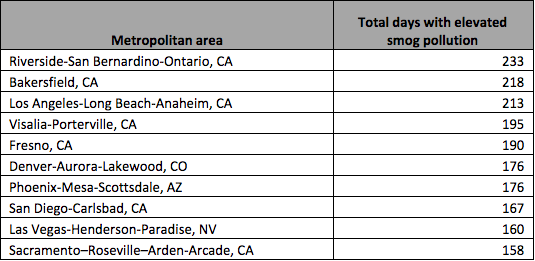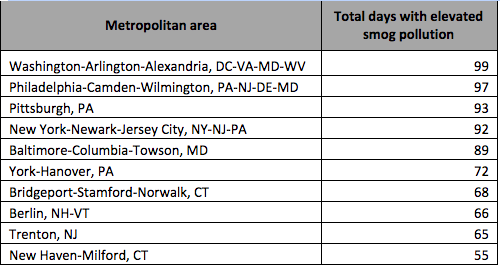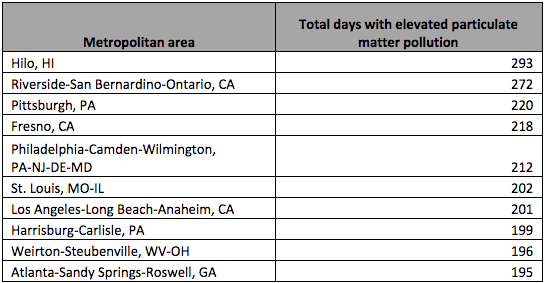
Our Health at Risk
Why Are Millions of Americans Still Breathing Unhealthy Air?
Despite decades of progress under the Clean Air Act, Americans across the country continue to breathe unhealthy air, leading to increased risk of premature death, asthma attacks and other adverse health impacts.
Downloads
Despite decades of progress under the Clean Air Act, Americans across the country continue to breathe unhealthy air, leading to increased risk of premature death, asthma attacks and other adverse health impacts.
In 2015, communities in 49 states plus the District of Columbia experienced at least one day of elevated ozone smog pollution, while many Americans who live in close proximity to industrial facilities and highways are exposed to health-threatening air pollution on a daily basis.
To protect public health, the nation needs to protect the gains made under the Clean Air Act and the Clean Cars Standards, and pursue additional pollution cuts through programs such as the Regional Greenhouse Gas Initiative, which reduces pollution from coal and natural gas power plants. These programs not only cut air pollution now but can also help reduce the health threats posed by air pollution in the future by curbing global warming emissions that will make air pollution worse.
Burning fossil fuels like coal, diesel, gasoline or natural gas creates air pollution in the form of smog, particulate matter and other toxic combustion products. There is no safe level of exposure to some of these pollutants.
- Smog, or ground-level ozone, causes a host of respiratory consequences, ranging from coughing, wheezing and throat irritation, to asthma, increased risk of infection, and permanent damage to lung tissue.
- Particulate matter can cause similar adverse respiratory consequences and also trigger a range of cardiovascular problems, including heart attacks, strokes, congestive heart failure, and reduced blood supply to the heart. These problems can result in increased hospital admissions or premature death. Particulate matter can also trigger premature birth, raise the risk of autism, stunt lung development in children, and increase the risk that they develop asthma. Recent studies also implicate particulate matter in an increased risk of dementia.
Elevated smog pollution – pollution that is above the level that the EPA has determined to pose “little to no risk” – affects people living in hundreds of communities across the U.S.
- Of the 10 cities with the most days of elevated smog pollution, seven were in California, along with the Denver, Phoenix and Las Vegas metropolitan areas. (See Table ES-1.)
- Residents of 34 metropolitan areas experienced more than 100 days in 2015 with elevated smog pollution. The Los Angeles, Salt Lake City, Albuquerque and Dallas-Fort Worth metropolitan areas were among those that faced elevated levels of smog for more than three months of the year.
Table ES-1. Metropolitan areas with the most days of elevated smog pollution, 2015

In densely populated Northeastern states, communities experienced frequent smog pollution in 2015, an indication that stronger measures are still needed to help curb air pollution in the region, despite recent progress.
- Residents of the Washington, Philadelphia, Pittsburgh, New York City and Baltimore metropolitan areas all experienced 89 or more days in 2015 of elevated levels of smog. (See Table ES-2.)
- Residents of smaller communities, such as York, Pennsylvania, and the Berlin area of New Hampshire and Vermont, also experienced frequent elevated smog levels.
Table ES-2. Northeastern cities with the most days of elevated smog pollution, 2015

Particulate matter pollution affected people living in a broad range of cities in 2015. Multiple metropolitan areas in California and Pennsylvania are among the communities experiencing chronic particulate matter pollution in 2015. (See Table ES-3.) Hilo, Hawaii, tops the list because of pollution from volcanic activity.
Table ES-3. Metropolitan areas with the most days of elevated particulate pollution, 2015

Millions of Americans may be exposed to air pollution even more severe than described here because they live in local pollution “hotspots,” such as near freeways, airports and industrial facilities. Studies have shown that people living close to these sources of pollution face greater health impacts than do residents across the region as a whole. For example, people who live near highly traveled roads are at increased risk of developing lung cancer, and at greater risk of death from stroke, lung disease and heart disease.
Communities may endure worse air pollution in the future as global warming creates conditions conducive to increased smog and particulate pollution. Higher temperatures will facilitate formation of smog, and altered wind patterns may increase the number of days with stagnant air that prevents dilution of contaminants. Wildfires, which generate particulate pollution and smog precursors that can travel hundreds of miles, will become more frequent and intense.
To address the air pollution problems affecting people in communities across the country, and to avoid global warming-related increases in air pollution in the future, the nation should:
- Defend and build upon improvements in air quality through the Clean Air Act. Pollution reductions achieved under the Clean Air Act helped prevent more than 160,000 early deaths, 130,000 non-fatal heart attacks, and 41,000 hospital admissions in 2010 alone. Maintaining the gains already achieved under the Clean Air Act and seeking greater emission reductions are crucial for ensuring that Americans can breathe cleaner air.
- Strengthen the Regional Greenhouse Gas Initiative and other programs to reduce global warming pollution and improve air quality. From 2009 to 2014, improved air quality due to the program avoided up to 830 premature deaths, 390 non-fatal heart attacks, and 47,000 lost work days from Virginia to Maine. Participating states should double the strength of the program to achieve greater cuts in power plant pollution that would bring about short- and long-term improvements in air quality. New Jersey should rejoin the program.
- Pursue other measures to reduce the use of coal and natural gas for electricity generation, such as increasing energy efficiency and boosting the use of wind and solar energy, with the goal of ultimately obtaining all of our energy from clean, renewable sources.
- Maintain existing standards and requirements in the Clean Cars Standards – the strong program of tailpipe emissions standards for cars adopted by California and other states, and eventually implemented nationwide beginning in 2009. The program has allowed states that suffer from elevated pollution to dramatically reduce pollution from cars and light trucks, and also spurred development of hybrid and zero-emission vehicles.
- Transition other forms of transportation to zero-carbon technologies. Freight trucks, airplanes, locomotives and other fossil fuel-powered engines are major sources of air pollution. These sources of air pollution can be better controlled as these forms of transportation are eventually transitioned to carbon-free modes.
Topics
Find Out More


Recording of Road to 100% Renewable Energy with Dr. Mark Jacobson

The Biden administration has released $1 billion in funding for urban trees. Here’s why that matters.


